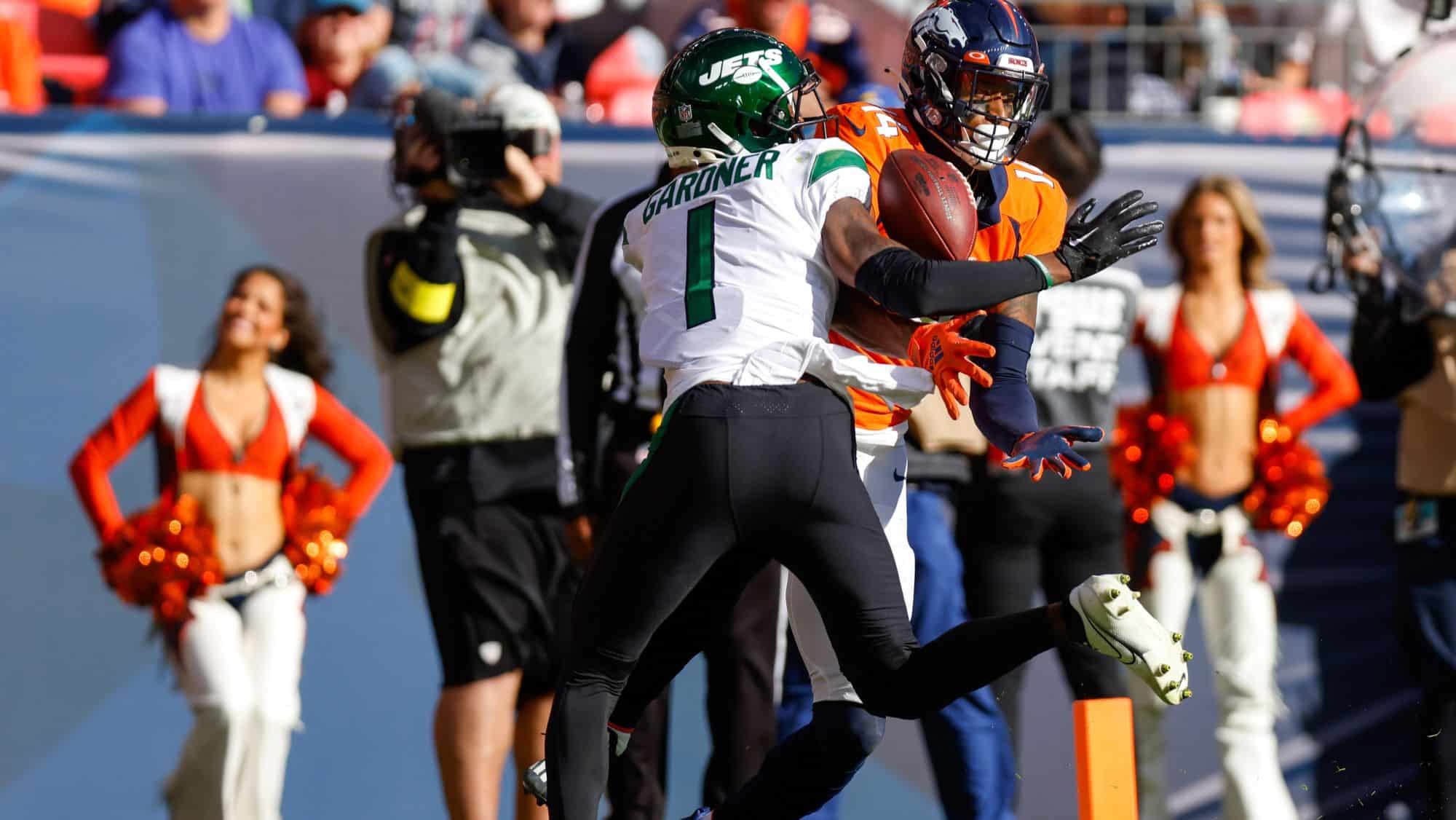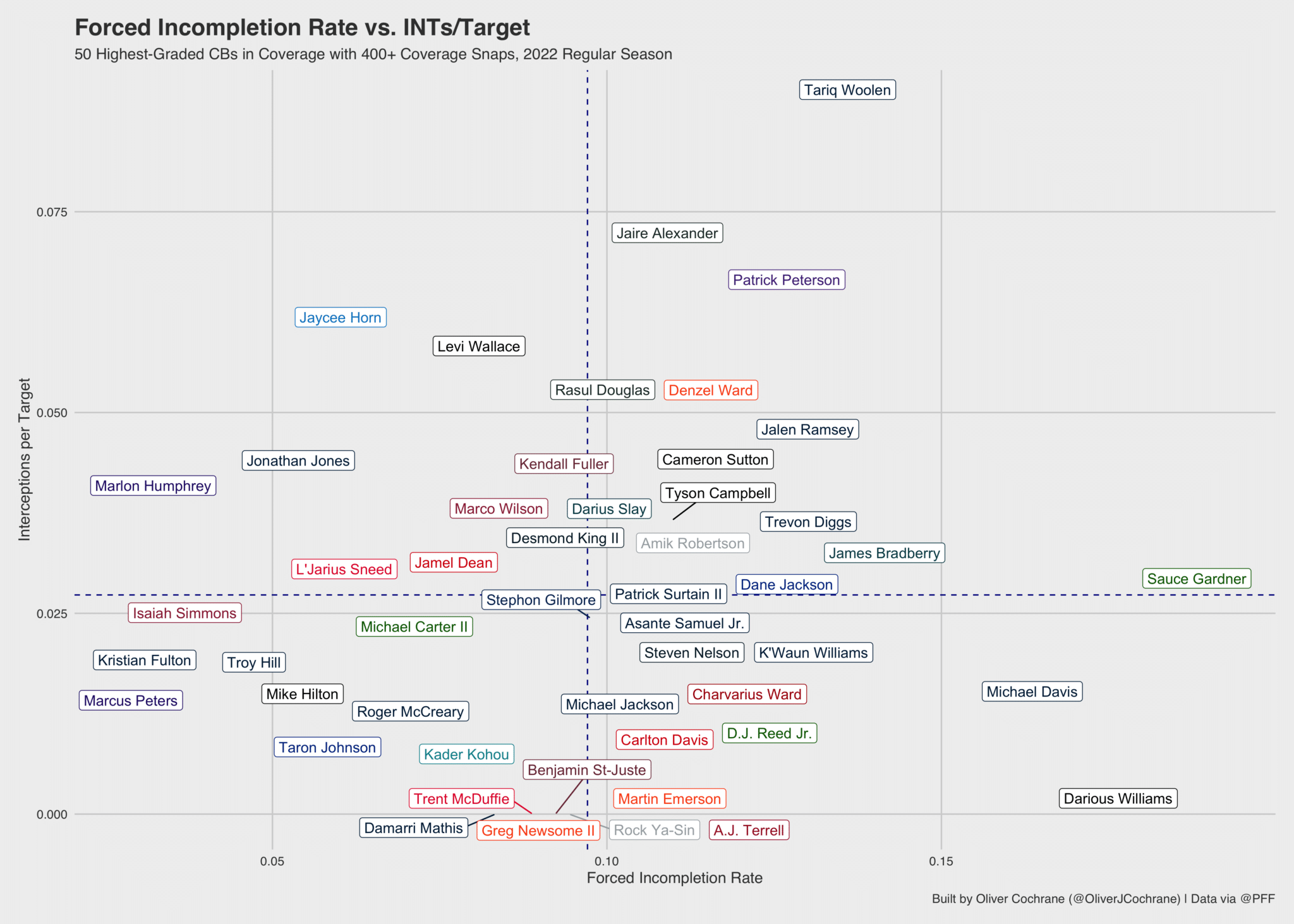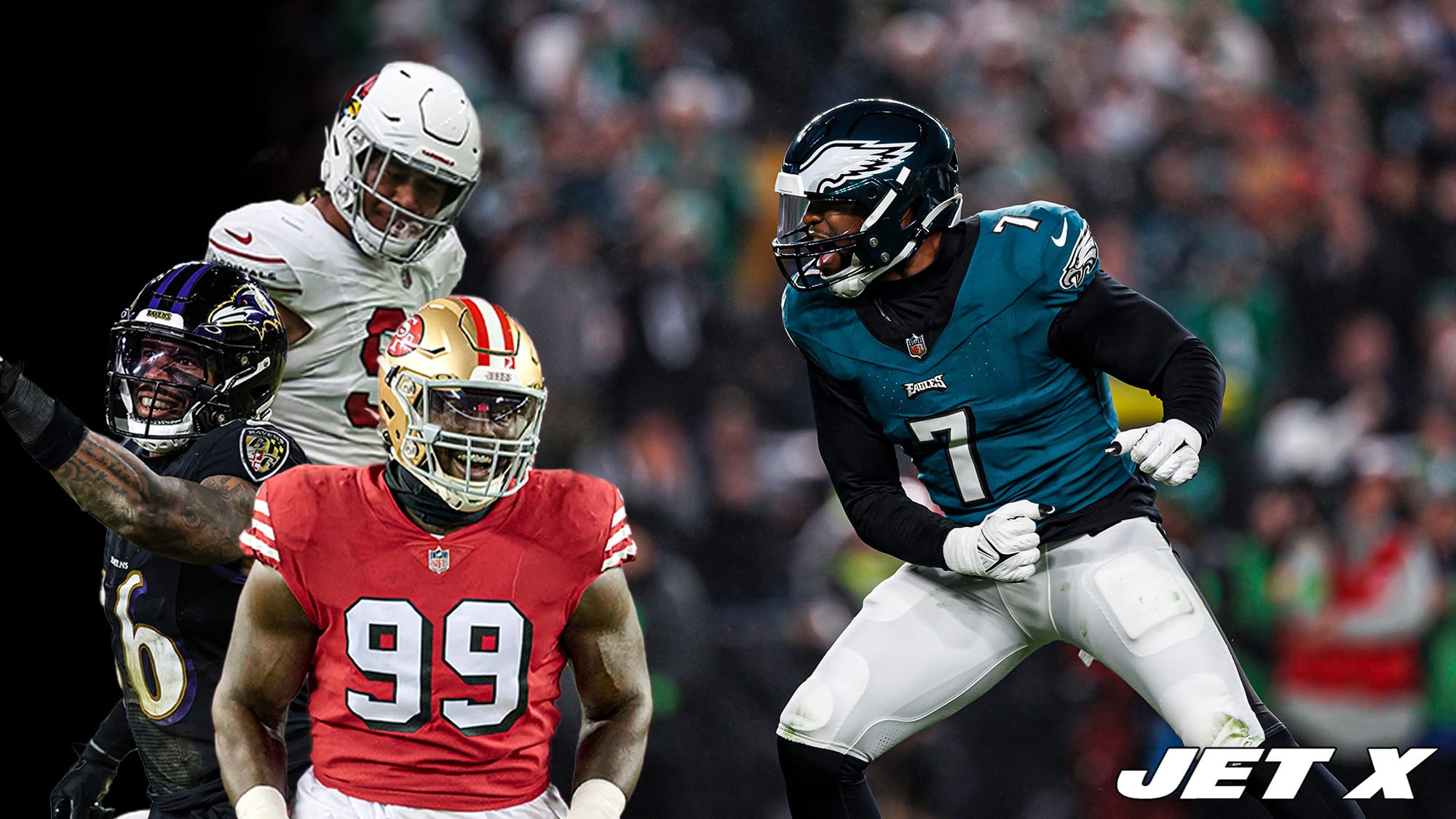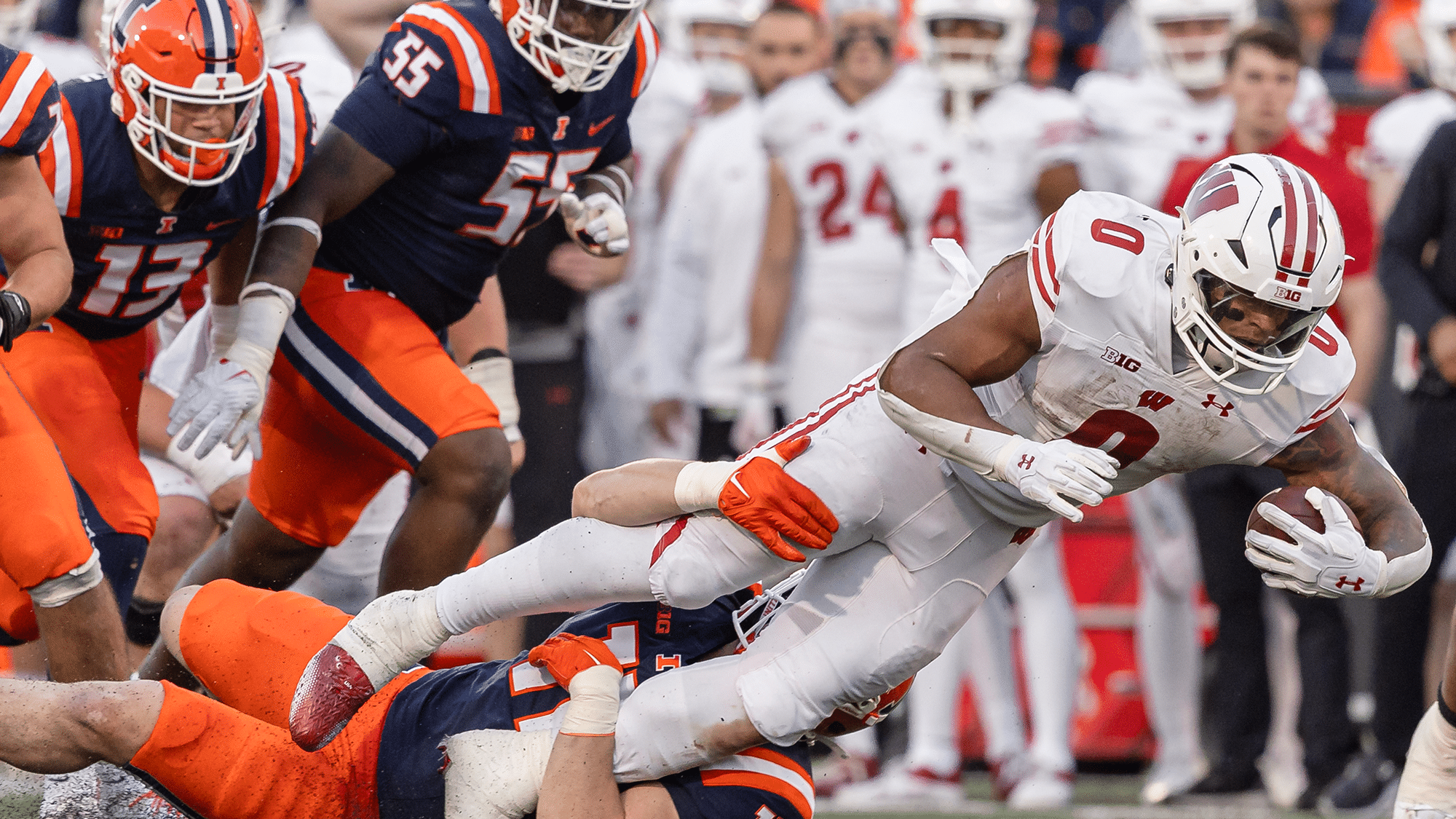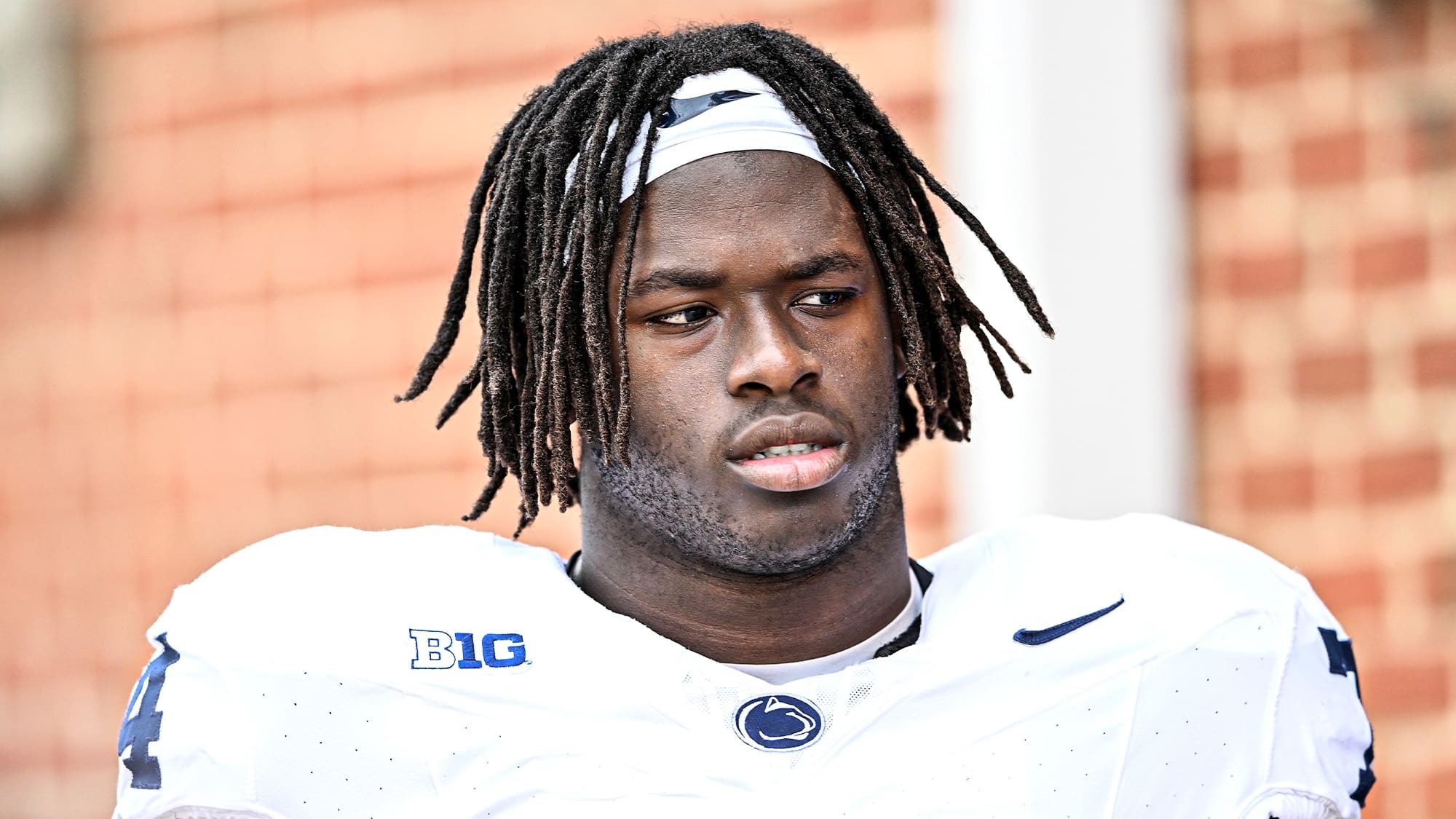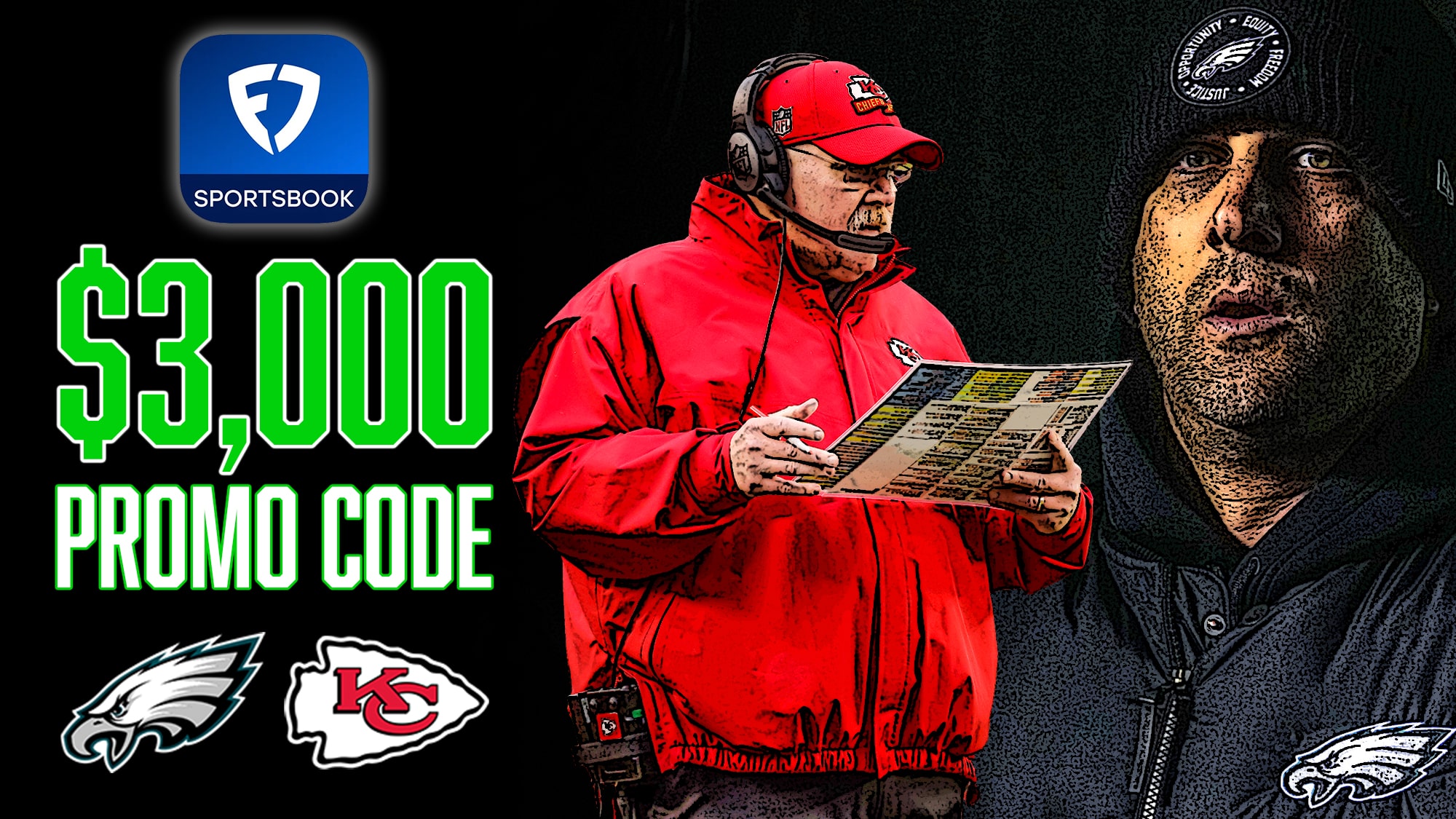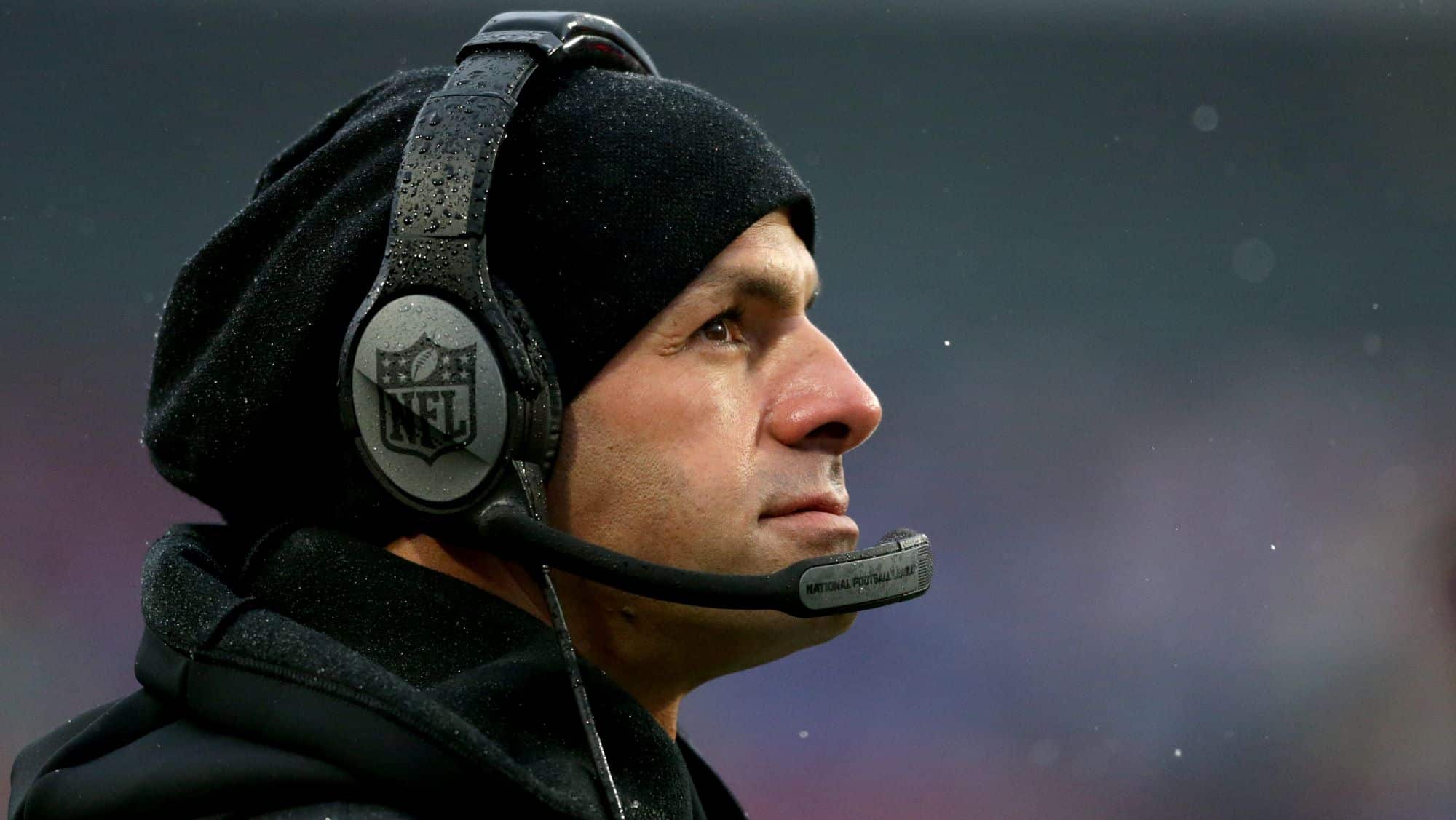So much for ‘Saleh doesn’t care about cornerbacks’
The New York Jets left no question marks with their cornerbacks for 2022. In particular, the cornerback room was a point of emphasis in both free agency and the draft after letting late-round picks get their shot at starting in 2021.
Head coach Robert Saleh and the Jets have traditionally preached “trench warfare” and relied on pass-rush to bail out mediocre cornerback play. The 2021 room of Bryce Hall (2nd year) and Brandin Echols (6th-round pick) outside, with Michael Carter II (5th-round pick) in the slot, conveyed that philosophy. The group was surprisingly sound, but far from perfect.
Fast-forward to now, and the Jets have arguably the best starting cornerback trio in the entire NFL. Saleh and general manager Joe Douglas assembled a group that was integral in turning a league-worst defense into a top-five unit in just one offseason.
Rookie Sauce Gardner (No. 4 overall pick), free-agent acquisition D.J. Reed, and second-year slot man Michael Carter II showed the league that they all have what it takes to be top-10—even top-five—in their respective roles.
Now that the 2022 season is finally over, I’m going to dive into the performance of these three starters. What were their strengths? What were their weaknesses? Where does the unit need the most help in 2022?
My analysis aims to provide insight into several key questions:
- Are they breaking up passes?
- How many yards are they allowing?
- How often are they being targeted?
- Are they creating interceptions when thrown at?
- Are they maintaining tight coverage?
- Are they limiting the damage after the catch?
I’ll address how they compare to one another and where they rank compared to cornerbacks across the rest of the league. To evaluate these questions, I’ve compiled data from Pro Football Focus (PFF) and player-tracking data from Next Gen Stats (NGS) to help answer the above questions:
PFF
- Forced Incompletion Rate
- Yards Allowed per Coverage Snap
- Targets per Coverage Snap
- Interceptions per Target
NGS
- Average Separation
- Missed Tackle Rate in passing game
My analysis considers the 50 highest-graded corners by PFF who played at least 400 snaps in coverage during the 2022 regular season. PFF grades are far from perfect, but they help outline roughly the top 50 corners around the league, making my analysis much easier to conduct and eliminating potential outliers.
With that out of the way, let’s dive into the numbers.
Are they breaking up passes?
One of the most essential jobs of a cornerback is to generate pass break-ups (PBUs). The Jets’ crew in 2022 did an excellent job of that. The sample average for corners was 9.8 PBUs, yet Rookie Sauce Gardner wound up with 20. That led the entire NFL.
Reed and Carter were no slouches, either, racking up 11 and 9 PBUs, respectively. These guys were routinely tested and seldom budged for offenses. It’s one thing to be able to cover tightly, but the ability to finish the play (whether it be a PBU or INT) remains the deciding factor in whether the job gets done.
Gardner also posted the highest forced incompletion rate of 19.2% to compare more fairly on a per-target basis. Reed was also top-10 at 12%, with Carter coming in at 7.6%.
For Sauce, it all started with this beauty in his NFL debut. It’s no easy task covering one of the league’s best at the tight-end position in the Ravens’ Mark Andrews. He does it perfectly.
Bringing the Sauce. Perfect play on Andrews. pic.twitter.com/PQCP6LSuxL
— David Wyatt-Hupton (@DWyattHupton) September 11, 2022
How many yards are they allowing?
Another staple metric of the CB position is yards allowed. Yards allowed per cover snap helps us understand how many yards corners allow on a per-snap basis. This way, we can compare corners with the most snaps and those with fewer on an even playing field.
The average among the aforementioned 50 corners was 0.94 yards allowed per cover snap in 2022. Sauce Gardner led qualifiers with just 0.54 yards allowed per cover snap—nearly half the mean. Reed came in not too far behind at 0.71 yards allowed per cover snap, who also was an elite cover corner opposite of Sauce.
Carter posted a mark of 1.11 yards allowed per cover snap, which is not as attractive as the former two. MC2 gave up a lot of yards early in the year before improving after the bye. He allowed 35 yards per game in weeks 1-9, but just 29 yards per game after the bye. Furthermore, slot corners litter the top of the yards per cover snap area simply because it is that much more difficult to shut down the middle of the field.
Ultimately, the three as a unit were one of the best in the league in this regard. You won’t find many other rooms that can cover like this one.
How often are they being targeted?
Sauce was targeted at the ninth-lowest rate among qualifiers—just 11.4% of cover snaps. Reed was shown a similar level of respect, ranking 18th at 12.6%. Carter came in at a respectable 16.1%, considering slot receivers tend to be targeted at a higher rate.
The first way to look at this: Sauce has already earned the island treatment. Earlier in the season, teams would consistently test him one-on-one. Time and time again, they’d come up empty. Eliminating some of the league’s best receivers from games tells future opponents one thing: don’t waste your time throwing at Sauce.
He even went the entire Detroit game without being targeted even once (against a top-10 offense, too).
Sauce Gardner was not targeted on a single one of his 38 coverage snaps against the Lions, tied for the 4th-most coverage snaps without a target by an outside cornerback in a game since 2017.#DETvsNYJ | #TakeFlight pic.twitter.com/BVpHPDPkxY
— Next Gen Stats (@NextGenStats) December 19, 2022
The Jets were one of only three teams to have three corners qualify in this analysis. Cleveland and Denver were the only others to do so. The respect this group garners is elite and teams continued to throw away from any corner in green and white in 2022.
Are they creating interceptions when thrown at?
Perhaps the flashiest part of a corner’s job is interceptions. You tend to find two general types of cornerbacks: ballhawks and cover corners. The former is about high IQ, play recognition, and aggressive moves to create turnovers.
This archetype tends to allow more yards in coverage, but they “make up for it” by generating a lot of turnovers (and I put that in quotes because it’s hard to be sure how yards allowed and turnovers correlate or correspond to overall performance). Think Trevon Diggs here.
Cover corners are guys who rely on pristine technique, excellent body control, and fluid feet/hips to stick like glue to receivers. They won’t allow many yards, but typically their playstyle results in fewer interceptions and more PBUs. It’s about taking guys out of the game with coverage. Think none other than the great Jets corner Darrelle Revis here.
With that being said, the Jets’ cornerbacks in 2022 were definitely cover corners. Gardner led the team in interceptions per target at 2.74%, barely clearing the league average of 2.73%.
Carter was just behind at 2.53%. Reed finished third of the bunch at just 1.20%. Sauce and Carter finished with two picks each, and Reed just one.
While the numbers aren’t great, it’s undoubtedly a drastic improvement over last season. Jets corners did not record an interception until Week 14 in 2021. The group has taken a significant step forward in the facet of the game they needed the most.
It’s also hard to forget about this would-be pick-six by Carter against the Patriots. It ended up being called back by a highly questionable roughing the passer call against defensive end John Franklin-Myers.
Roughing the passer erases a brutal 84-yard pick six thrown by Mac Jones. pic.twitter.com/H6mByt9emG
— Doug Kyed (@DougKyed) October 30, 2022
Are they maintaining tight coverage?
NFL Next Gen Stats has introduced new ways to analyze football for fans and professionals alike. A big piece to this puzzle is using player tracking data. The ability to get real-time distances, speeds, and locations all over the field unlocks new ways to evaluate the players.
One that can give some context into the coverage of a defender is the average separation at the catch point. NGS defines average separation as “the average distance between the receiver and the nearest defender at pass arrival.”
D.J. Reed finished tied for 12th among qualified defensive backs with an average separation of 2.1 yards. Gardner and Carter logged marks of 2.5 yards and 3.5 yards, respectively. The overall ranks are not bad, but the numbers likely seem unusually large.
It’s not worth putting too much stock into this. Positional tracking data has no designations for play-call; therefore, the responsibilities of each player on the field aren’t reflected in the data.
For example, Sauce might be the closest defender to the receiver in terms of raw distance, but that doesn’t mean that’s who he is responsible for. NGS would charge him with those yards allowed, and therefore separation distance, simply because he was the closest defender in terms of distance.
Consider this play, on which NGS charges Sauce with a touchdown allowed due to Lamarcus Joyner’s blown coverage. (PFF went back and changed that charge to Joyner after an outcry from Jets fans and Sauce’s own admonishment on Twitter.)
Mac Jones to Jakobi Meyers for a TD on 4th down pic.twitter.com/hGPg9uiUJi
— Main Team (@MainTeamSports2) October 30, 2022
I wanted to include this statistic because I still think it holds some value when looking at the top cover corners in the league. However, there is definitely room for improvement. The stat should become much more accurate and meaningful over time.
Are they limiting the damage after the catch?
One area that many modern offenses are built on is gaining yards after the catch. The playbook becomes less about driving the ball and attacking downfield and more about scheming receivers into open space to let them run with the ball on an easy completion.
As a cornerback, it’s important to be able to prevent receivers from getting lost in the open field. Even if you can’t make a play on the ball, bringing the receiver down at the catch point keeps the bad from worsening.
All it takes is one missed tackle in the secondary to give up a touchdown.
Looking at the Jets’ starters, Sauce Gardner leads the room with a missed tackle rate of just 5.8%. D.J. Reed also finished in a good spot at 8.8%, with Carter a bit farther behind at 10.2%.
Considering that the mean among qualifiers was 9.97%, the Jets grade out pretty well. All of them are about average or better, which was apparent when watching them play in 2022. The missed tackle situation seemed to be a more significant issue among the linebackers and the safeties for sure.
See how the Jets’ corners stack up against the NFL
With the gritty numbers and explanations out of the way, it’s time to see how the Jets’ corners compare to their NFL peers.
I’ve prepared a series of graphs to highlight the stats we’ve discussed for 50 corners from the 2022 regular season.
This first plot helps demonstrate the ball skills of qualified corners. The graph compares the forced incompletion rate and interception rate. The dashed horizontal and vertical lines represent the mean among qualifiers.
Sauce Gardner is off in a special tier leading the league in forced incompletion rate, yet he also was above average in terms of creating interceptions when targeted. His ball skills are certainly great.
Reed is also toward the front of the pack in terms of forced incompletion rate. To see him among the likes of James Bradberry, Jalen Ramsey, and even clearing Patrick Surtain II is an excellent sight to see. Carter checks in around the middle of the pack.
This next plot shows targets per cover snap (target rate) compared to yards per cover snap allowed. It gives us some idea of how much respect opponents afforded to these cornerbacks vs. their actual effectiveness in coverage.

Sauce commanding the seventh-lowest target rate among qualifiers as a rookie shows the respect he’s earned with elite play. Teams learned quickly not to test him. Carter was on-par with the prediction of the linear regression model, though he certainly has room to improve.
With the NFL Honors approaching this Thursday, it’s worth noting the location of Gardner and rookie Tariq Woolen from the Seahawks as they vie for the Defensive Rookie of the Year Award. Sauce Gardner was targeted at a higher rate than Woolen, yet he allowed yards at a rate roughly 60-70% lower than Woolen.
My last plot shows the relationship between yards allowed per cover snap (horizontal axis) and interceptions per target (vertical axis) to distinguish playstyle.
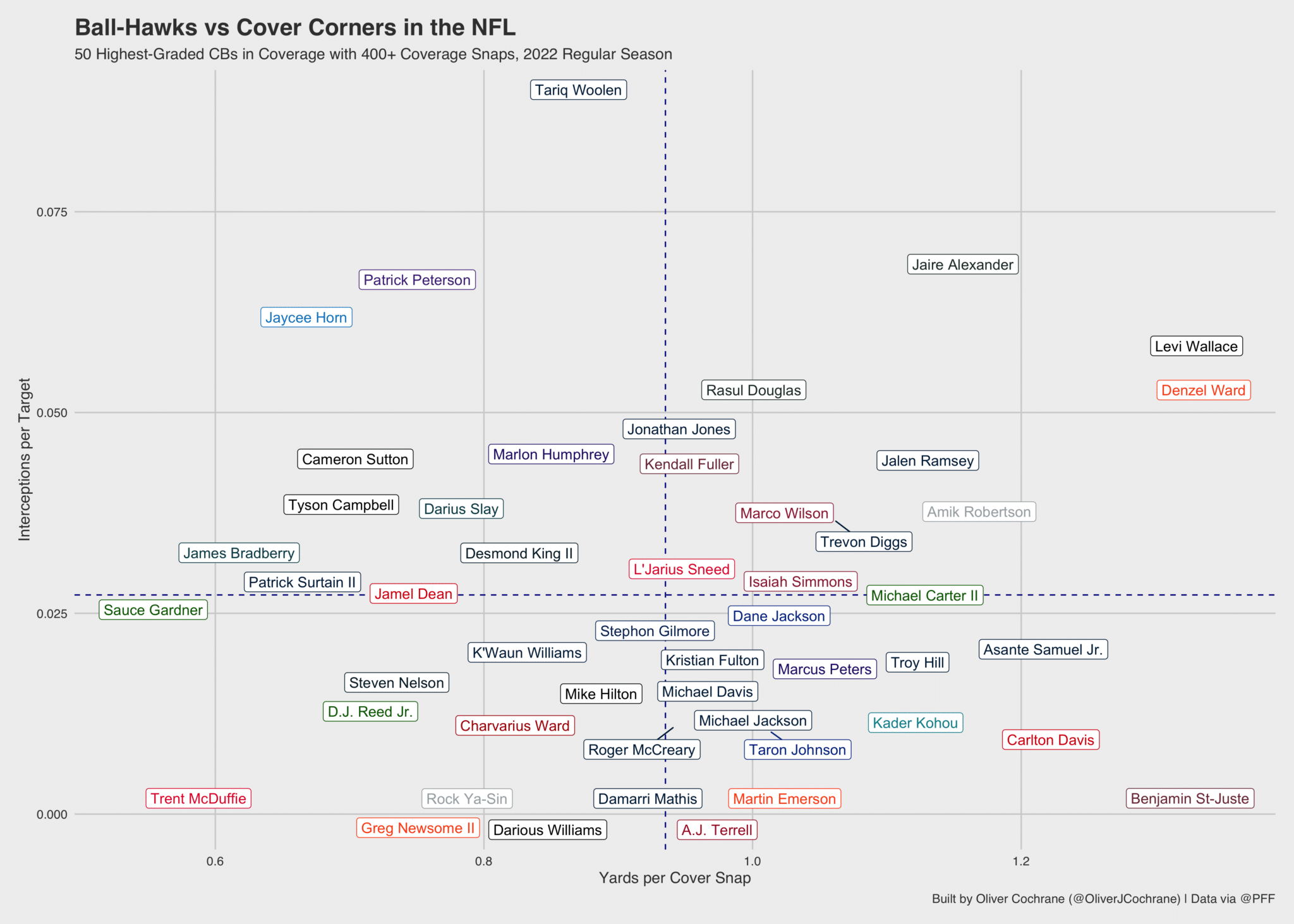
Reed stands out as another elite coverage corner. His importance as a free agent signing last offseason can’t be undervalued, as a player and as a mentor to the young Gardner.
Carter continues to float around the average mark, which is not a bad spot to be in. I will be one to argue that he was better this year than the stats alone say, and he’s had some stretches of true excellence in the slot.
To continue the debate, Woolen was excellent at generating turnovers compared to Sauce. Woolen tied the league lead for interceptions with six, but his efficiency was remarkable as a day-three pick.
This comes right back to my original point: do you choose elite coverage in Sauce Gardner with a couple of turnovers? Or elite turnover generation with some leakier coverage? That will be for the judges to decide this Thursday (I’m sure Jets fans have their minds made up already).
For anyone interested, you can find the code behind my analysis and these visuals on my GitHub here.
Outlook for 2023
Last year, I finished this analysis with some suggestions for how to improve the cornerback room for 2022. While the Jets’ organization did the exact opposite of my suggestion, they managed to overhaul the group into one of the league’s best.
Heading into 2023, there isn’t anything to be changed. Let Sauce and Reed continue to dominate against the premier wideouts of the NFL, and let Carter continue to work in the slot as a solid option.
If any changes are made, I would suggest testing the trade market for Bryce Hall. After starting all of 2021 and playing at a relatively high level, he saw only a handful of sporadic moments in 2022.
Since it’s clear the team does not see him as a starter, and since Brandin Echols has proven to be a reliable backup when called upon this past season, you might be best off flipping Hall for a mid-round pick to address other needs (a mid-round safety comes to mind first for me).
The Jets are doing a disservice having Hall ride the bench, and if they do end up making a splash trade for a quarterback (yes you, Aaron Rodgers) then they will need to recoup some draft capital.
Ultimately, the one-year leap of improvement from not just the corners, but the entire defense, was extremely impressive. Credit to the rookies and vet, and credit to Saleh and defensive coordinator Jeff Ulbrich. Both took extreme heat for a league-worst defense in 2021, but the top-5 unit in 2022 can be a force to be reckoned with going forward.

